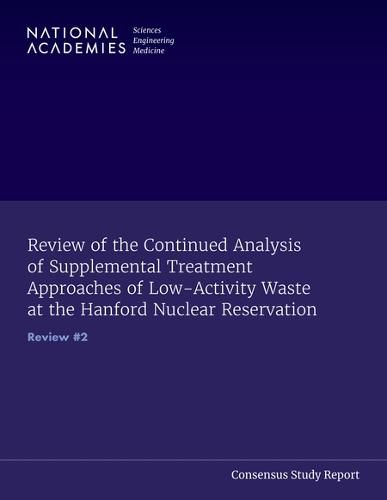Readings Newsletter
Become a Readings Member to make your shopping experience even easier.
Sign in or sign up for free!
You’re not far away from qualifying for FREE standard shipping within Australia
You’ve qualified for FREE standard shipping within Australia
The cart is loading…






The Hanford Nuclear Reservation in Washington state, which produced plutonium for nuclear weapons from 1944-1987, is the site of the largest and most complex nuclear cleanup challenge in the United States. The U.S. Department of Energy's Office of Environmental Management (DOE-EM) is responsible for managing the cleanup of the radioactive and other hazardous wastes stored in 177 underground tanks at the site. DOE plans to use vitrification, or immobilization in glass waste forms, for all of the high-level radioactive waste at Hanford. However, because the volume of "low-activity waste" exceeds DOEs capacity limits for vitrification, DOE must decide how to treat the remaining "supplemental low-activity waste" (SLAW) so that it can be safely disposed in a near-surface disposal site. To help inform its decision, DOE contracted with a Federally Funded Research and Development Center (FFRDC), led by Savannah River National Laboratory, to analyze and report its findings about three potential alternative technologies.
At the request of Congress, the National Academies reviewed the FFRDC report in terms of its value for decision making and how well it meets various Congressional requirements related to Hanford cleanup. The review concludes that the FFRDC report is overall very strong, provides a useful framework for evaluating the technology options, and is responsive to guidance from the first National Academies review. The framework provides for structured side-by-side comparisons, using relevant criteria, of a limited number of alternatives for managing SLAW. Recommendations for strengthening the report include estimating a lifecycle cost profile for constructing and operating each alternative, and providing more in-depth discussion on potential challenges that may need to be addressed in obtaining the necessary various regulatory approvals.
Table of Contents
Front Matter Summary 1 Context and Setting 2 The Committee's Technical Review of the FFRDC's Complete Draft Report 3 The Committee's Observations Concerning the FFRDC's Draft Report References Appendix A: Section 3125 of Fiscal Year 2021 National Defense Authorization Act and Section 3134 of the Fiscal Year 2017 National Defense Authorization Act Appendix B: Statement of Task Appendix C: Presentations at the Committee's Information-Gathering Meetings and List and Summary of Comments Received During the Public Comment Period Appendix D: Acronyms and Abbreviations Appendix E: Biographical Sketches of the Committee, Technical Consultant, and Study Director
$9.00 standard shipping within Australia
FREE standard shipping within Australia for orders over $100.00
Express & International shipping calculated at checkout
The Hanford Nuclear Reservation in Washington state, which produced plutonium for nuclear weapons from 1944-1987, is the site of the largest and most complex nuclear cleanup challenge in the United States. The U.S. Department of Energy's Office of Environmental Management (DOE-EM) is responsible for managing the cleanup of the radioactive and other hazardous wastes stored in 177 underground tanks at the site. DOE plans to use vitrification, or immobilization in glass waste forms, for all of the high-level radioactive waste at Hanford. However, because the volume of "low-activity waste" exceeds DOEs capacity limits for vitrification, DOE must decide how to treat the remaining "supplemental low-activity waste" (SLAW) so that it can be safely disposed in a near-surface disposal site. To help inform its decision, DOE contracted with a Federally Funded Research and Development Center (FFRDC), led by Savannah River National Laboratory, to analyze and report its findings about three potential alternative technologies.
At the request of Congress, the National Academies reviewed the FFRDC report in terms of its value for decision making and how well it meets various Congressional requirements related to Hanford cleanup. The review concludes that the FFRDC report is overall very strong, provides a useful framework for evaluating the technology options, and is responsive to guidance from the first National Academies review. The framework provides for structured side-by-side comparisons, using relevant criteria, of a limited number of alternatives for managing SLAW. Recommendations for strengthening the report include estimating a lifecycle cost profile for constructing and operating each alternative, and providing more in-depth discussion on potential challenges that may need to be addressed in obtaining the necessary various regulatory approvals.
Table of Contents
Front Matter Summary 1 Context and Setting 2 The Committee's Technical Review of the FFRDC's Complete Draft Report 3 The Committee's Observations Concerning the FFRDC's Draft Report References Appendix A: Section 3125 of Fiscal Year 2021 National Defense Authorization Act and Section 3134 of the Fiscal Year 2017 National Defense Authorization Act Appendix B: Statement of Task Appendix C: Presentations at the Committee's Information-Gathering Meetings and List and Summary of Comments Received During the Public Comment Period Appendix D: Acronyms and Abbreviations Appendix E: Biographical Sketches of the Committee, Technical Consultant, and Study Director